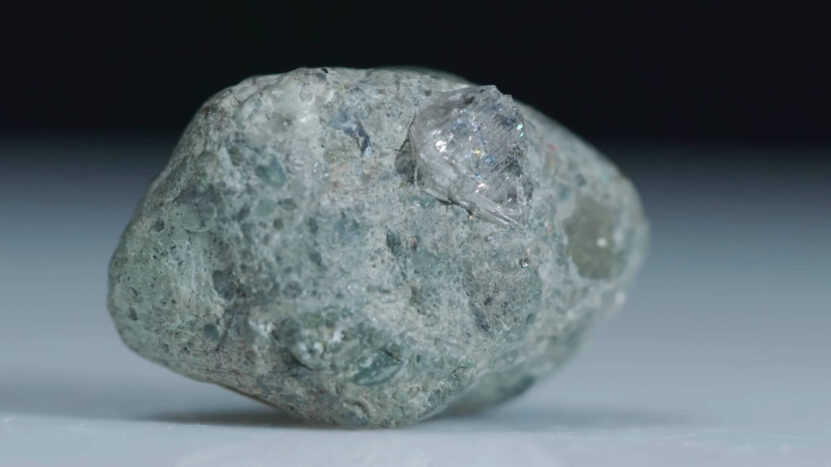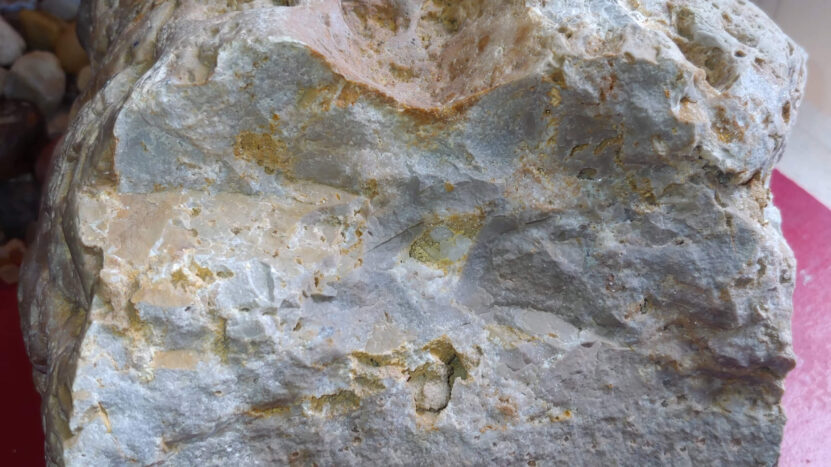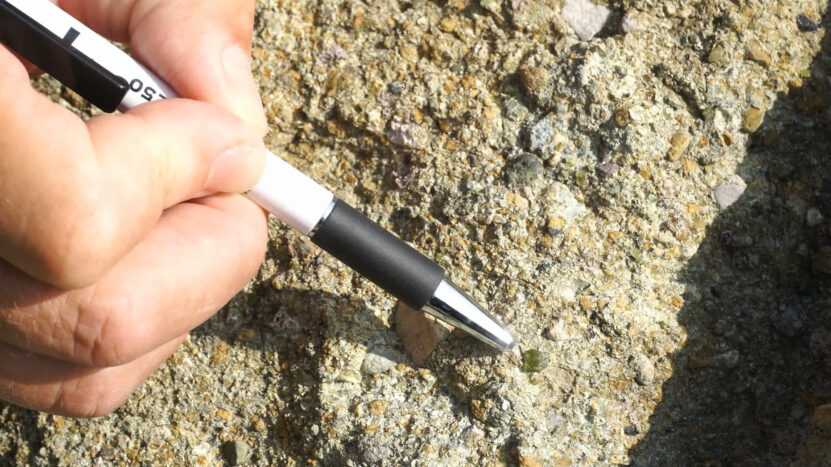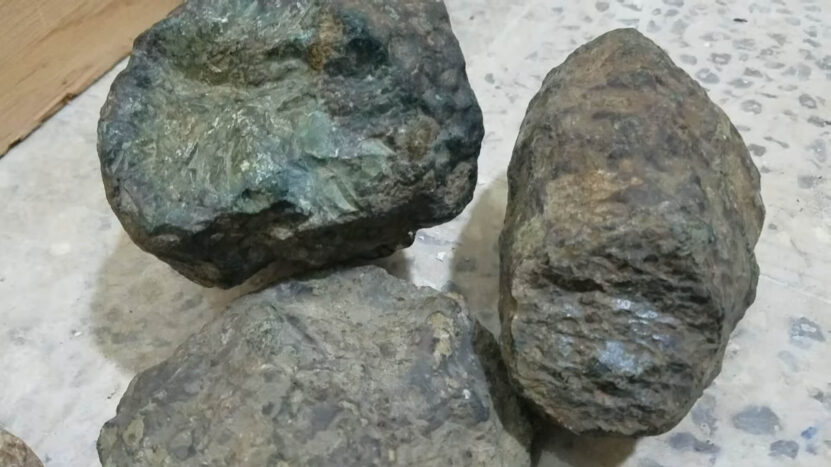Kimberlite is a unique rock that often gets people excited because it can contain valuable gems like diamonds. If you’re out exploring or happen to come across a strange-looking rock, you might wonder if it’s kimberlite.
Luckily, there are a few simple ways to tell. You don’t need to be a geologist to spot key features like its color, texture, or even how heavy it feels in your hand. A few easy tests, like checking if it’s magnetic or looking for small gems inside, can give you a pretty good idea.
These Are The Key Features
- Bluish or yellowish color
- Rough texture with visible spots or specks
- Hard to scratch
- Feels heavier than usual
- Magnetic
- Contains small gems like garnets or diamonds
1. Color

One of the easiest ways to identify kimberlite is by looking at its color. Unweathered kimberlite, often called “blue ground,” typically appears bluish, dark gray, or even greenish in some cases. This blue hue comes from the presence of minerals like magnetite and serpentine, which are common in fresh kimberlite.
As the rock weathers and oxidizes, it takes on a more yellowish-brown appearance, referred to as “yellow ground.” The yellowish tint is due to the transformation of magnetite into limonite as it’s exposed to the elements.
In terms of global distribution, kimberlite formations are found in regions like Africa, Russia, and Canada. One famous example is the Kimberley diamond mine in South Africa, where weathered yellow kimberlite was first recognized.
2. Texture

The texture of kimberlite is one of the most distinctive traits that sets it apart from other rocks. It typically has a porphyritic texture, which means you’ll notice large, rounded crystals (called phenocrysts) surrounded by a finer-grained groundmass.
These larger crystals can include important minerals like olivine, pyrope garnet, and sometimes even diamonds. The mix of different mineral sizes creates a patchy, rough appearance that’s hard to miss.
Kimberlite is often described as having a dense and gritty feel. When you pick up a piece, it’s easy to feel how rough and uneven the surface is. This texture is a result of the rock’s formation deep in the Earth, where different minerals crystallize at varying rates.
For anyone examining it, the texture almost feels as though the rock has both hard and soft spots, due to the combination of tough minerals like olivine with finer, softer materials.
Geologists also note that kimberlite tends to contain visible specks or patches of other minerals, like garnets or ilmenite.
These specks stand out against the darker matrix and can give the rock a somewhat glittery or spotted look. These visual cues make it easier to differentiate from other common surface rocks.
In some cases, kimberlite is so densely packed with different minerals that it can be hard to break apart. Miners often have to crush or soak it to extract the valuable materials inside, including diamonds.
3. Hardness

Kimberlite stands out because of its toughness, sitting between 6 and 7 on the Mohs Hardness Scale.
This level of hardness makes it significantly harder than most everyday rocks like limestone or sandstone, which are much easier to scratch.
When handling a piece of kimberlite, you’ll notice that it’s tough to scratch with common tools like a knife or even a steel file. This makes it a useful indicator for anyone trying to figure out if they’ve found kimberlite.
The hardness of kimberlite is largely due to the minerals that make up the rock, especially olivine and pyrope garnet, both of which are extremely hard. Olivine, in particular, is known for its durability and is a major component of kimberlite.
So, if you find a rock that’s tough to scratch or break, it could be a solid sign that you’ve got a piece of kimberlite on your hands.
4. Weight
Kimberlite tends to feel heavier than most other rocks of a similar size, which is a key indicator when trying to identify it. This is because it contains dense minerals like olivine, pyrope garnet, and chromite, all of which contribute to its weight.
When you pick up a piece, it might surprise you with how much heavier it feels compared to regular surface rocks like shale or granite.
The added weight comes from the high concentration of these minerals, especially magnetite and ilmenite, which have a much higher density than the surrounding material.
For example, olivine, a primary component of kimberlite, has a density of around 3.2 to 3.4 grams per cubic centimeter, making the rock significantly denser than most surface rocks.
5. Magnetism
One of the easiest ways to identify kimberlite is by checking if it’s magnetic. Kimberlite contains magnetite, a mineral that responds to magnets. This feature can make it easier to spot when you’re unsure about a rock’s identity.
All you need is a simple magnet. Hold it close to the rock and see if there’s any pull. If the magnet is attracted to the rock, there’s a good chance it could be kimberlite.
This magnetic property is due to the presence of iron-rich minerals in the rock. Magnetite, a key component of kimberlite, is a naturally magnetic mineral that gives the rock this unique feature.
Though not as strong as pure magnetite, the presence of these minerals makes kimberlite slightly magnetic, enough for a regular magnet to detect.
6. Presence of Gems

One of the most exciting features of kimberlite is that it often contains precious gems, especially diamonds. These gems are usually small and embedded within the rock matrix. Kimberlite is the primary source of diamonds, making it highly sought after by prospectors.
The gems are often surrounded by other key minerals like garnets and chromite, which also help in identifying the rock.
The gems in kimberlite form deep within the Earth’s mantle and are brought to the surface by volcanic activity. Diamonds found in kimberlite are usually macrocrysts or megacrysts, meaning they can vary in size but are still visible to the naked eye if you look closely enough.
Other minerals, like pyrope garnets, are also common in kimberlite and add to its visual appeal, giving the rock a speckled appearance.
FAQs
What is the difference between kimberlite and lamproite?
Kimberlite and lamproite are both igneous rocks that can contain diamonds, but they form under different conditions. Kimberlite comes from low-heat flow areas and tends to have a carrot-shaped structure, while lamproite forms in high-heat regions and often contains more potassium-rich minerals.
Can kimberlite be found in the United States?
Yes, kimberlite has been found in several U.S. states, including Colorado, Wyoming, Kansas, and Kentucky. While not all kimberlite pipes contain diamonds, some areas, like the Crater of Diamonds in Arkansas, are famous for diamond discoveries.
What tools are used to mine kimberlite?
Mining kimberlite often involves heavy machinery, like crushers and separators, to break apart the dense rock and extract diamonds. For exploration, geologists use magnetic and electromagnetic surveys to locate kimberlite pipes deep underground.
How can I tell if my rock is diamond-bearing kimberlite?
To determine if your rock contains diamonds, you’ll need a detailed analysis, which can involve crushing the rock to separate the minerals or using X-ray fluorescence. However, visible signs like garnets or other indicator minerals can suggest the presence of diamonds.
What is the value of kimberlite?
Kimberlite itself is not highly valuable unless it contains diamonds. The value of a piece of kimberlite depends on the presence of diamonds or other valuable minerals within it.
The Bottom Line
Kimberlite is a fascinating rock due to its potential to contain diamonds and other valuable minerals. Its key identifying features, like color, texture, hardness, weight, magnetism, and the presence of gems, make it possible to distinguish it from other rocks with just a few simple tests.
While it might seem challenging to spot at first, a little attention to detail goes a long way when identifying kimberlite in the field.
